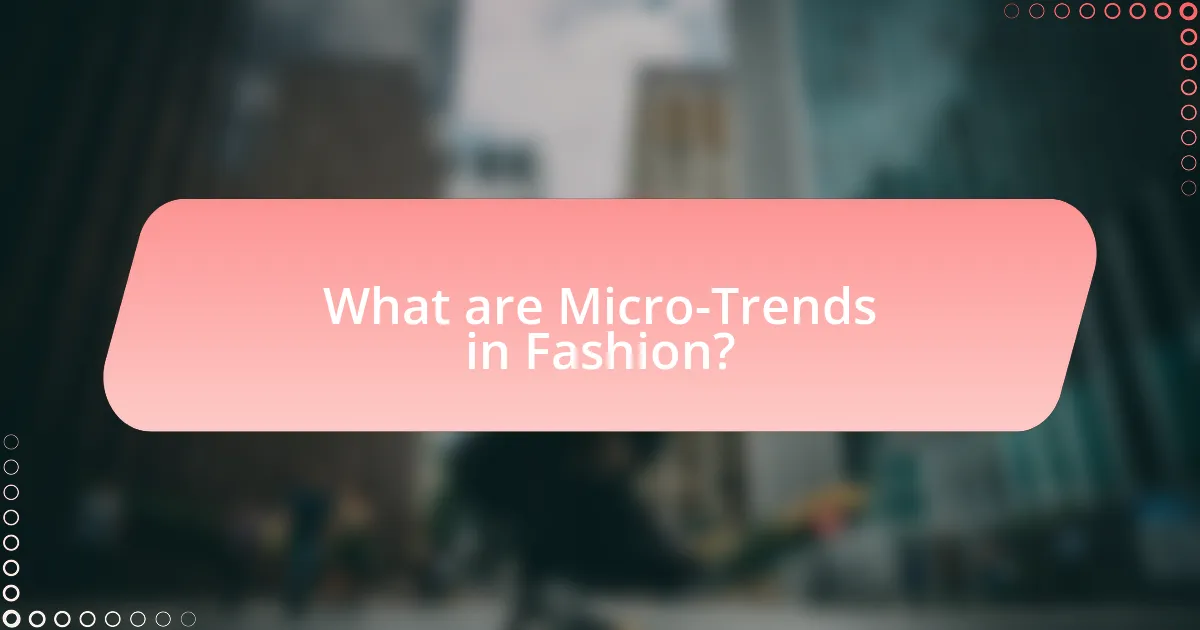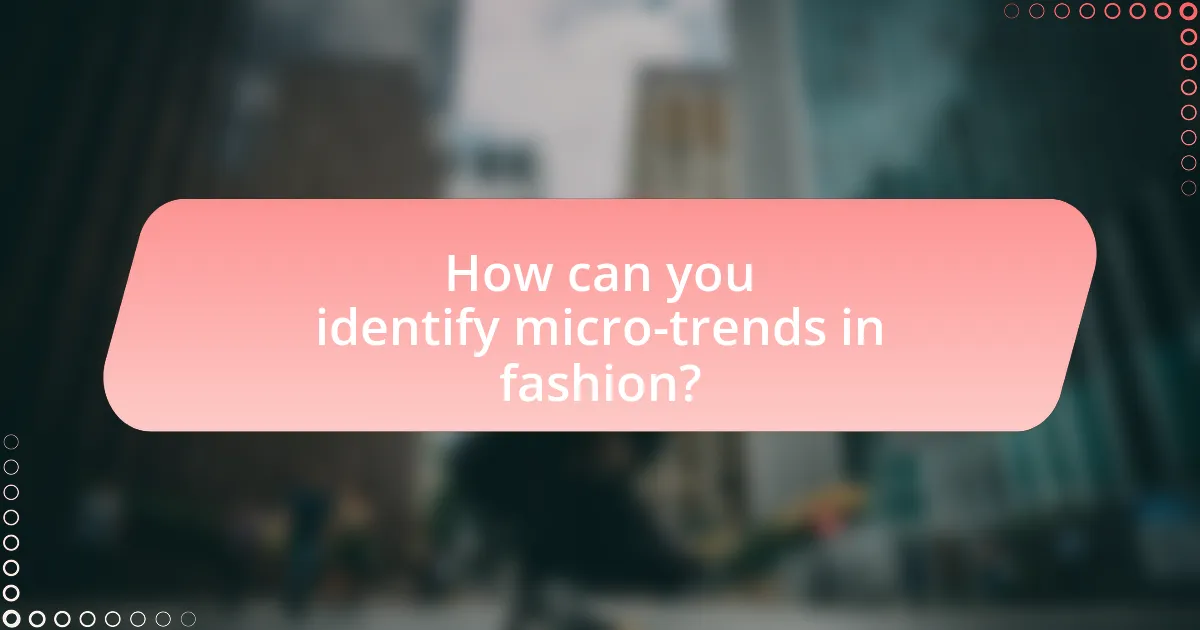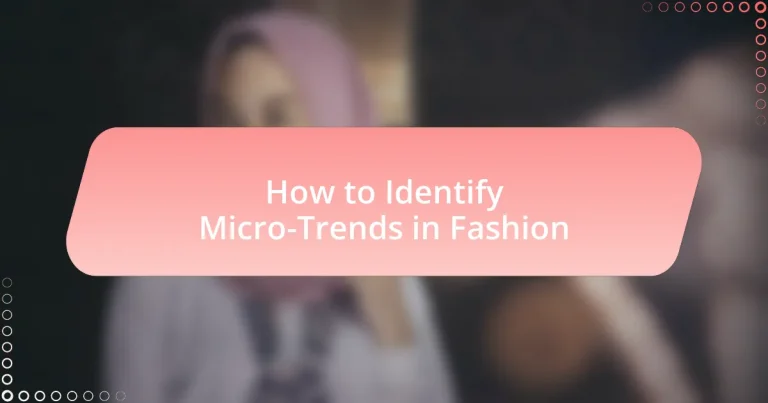Micro-trends in fashion are defined as short-lived styles that quickly gain and lose popularity, often emerging from social media and cultural shifts. This article explores the characteristics that distinguish micro-trends from macro-trends, emphasizing their niche appeal and rapid evolution. It discusses the factors contributing to the emergence of micro-trends, including social media dynamics and influencer impact, while providing practical strategies for identifying and tracking these trends through data analysis and consumer behavior insights. Additionally, it highlights best practices for monitoring social media, analyzing engagement metrics, and avoiding common pitfalls in trend analysis.

What are Micro-Trends in Fashion?
Micro-trends in fashion are short-lived styles that gain popularity quickly and often fade away just as fast. These trends typically emerge from social media platforms, influencers, and cultural shifts, reflecting the fast-paced nature of contemporary fashion. For instance, the rise of specific colors, patterns, or clothing items can be observed through platforms like Instagram or TikTok, where trends can go viral within weeks. The rapid cycle of micro-trends is supported by data showing that fashion consumption patterns have shifted towards immediacy, with consumers increasingly seeking novelty and variety in their wardrobes.
How do micro-trends differ from macro-trends?
Micro-trends are short-lived, niche trends that typically emerge within specific subcultures or communities, while macro-trends are broader, long-lasting trends that influence entire industries or societies. Micro-trends often reflect immediate consumer preferences and can change rapidly, whereas macro-trends represent significant shifts in behavior or attitudes that develop over time and have a more substantial impact on market dynamics. For example, the rise of sustainable fashion can be seen as a macro-trend, while the popularity of a specific type of eco-friendly accessory within a small demographic would be classified as a micro-trend.
What characteristics define a micro-trend?
A micro-trend is characterized by its niche appeal, rapid emergence, and short lifespan within a specific demographic or cultural context. These trends often arise from social media influences, grassroots movements, or specific subcultures, allowing them to gain traction quickly among targeted audiences. For example, the rise of cottagecore aesthetics in fashion illustrates how micro-trends can reflect broader societal shifts, such as a desire for nostalgia and simplicity during times of uncertainty. Additionally, micro-trends typically last from a few months to a couple of years, distinguishing them from macro-trends, which endure for longer periods.
Why are micro-trends important in the fashion industry?
Micro-trends are important in the fashion industry because they reflect rapidly changing consumer preferences and can drive significant sales. These trends often emerge from social media, influencers, and cultural shifts, allowing brands to quickly adapt their offerings to meet current demands. For instance, the rise of sustainable fashion as a micro-trend has led to a 27% increase in sales for brands that prioritize eco-friendly practices, demonstrating how micro-trends can directly impact market performance. By identifying and leveraging these trends, fashion companies can maintain relevance and competitiveness in a fast-paced market.
What factors contribute to the emergence of micro-trends?
The emergence of micro-trends is primarily influenced by social media dynamics, cultural shifts, and consumer behavior changes. Social media platforms enable rapid dissemination of ideas and styles, allowing niche trends to gain visibility and traction quickly. Cultural shifts, such as increased awareness of sustainability, can drive micro-trends focused on eco-friendly fashion choices. Additionally, consumer behavior changes, including the desire for individuality and personalization, contribute to the rise of micro-trends as people seek unique expressions of style. These factors collectively create an environment where micro-trends can flourish and evolve swiftly.
How do social media platforms influence micro-trends?
Social media platforms influence micro-trends by enabling rapid dissemination and visibility of niche interests among users. These platforms, such as Instagram and TikTok, allow individuals to share content that resonates with specific audiences, leading to the emergence of micro-trends that can gain traction quickly. For instance, a study by the Pew Research Center found that 69% of adults in the U.S. use social media, which facilitates the spread of ideas and styles that may not have been mainstream previously. This interconnectedness allows for trends to evolve and adapt based on user engagement, creating a feedback loop that amplifies certain styles or products.
What role do influencers play in shaping micro-trends?
Influencers play a crucial role in shaping micro-trends by leveraging their platforms to introduce and popularize niche styles and products. They often curate content that resonates with specific audiences, creating a ripple effect where followers adopt these trends, leading to broader acceptance. For instance, a study by the Digital Marketing Institute found that 49% of consumers depend on influencer recommendations for their purchasing decisions, highlighting the significant impact influencers have on consumer behavior and trend formation.

How can you identify micro-trends in fashion?
To identify micro-trends in fashion, analyze social media platforms, fashion blogs, and street style for emerging patterns and shifts in consumer behavior. These platforms often showcase real-time insights into what styles, colors, and silhouettes are gaining traction among specific demographics. For instance, data from platforms like Instagram and TikTok reveal that certain hashtags or viral challenges can indicate rising trends, as seen with the popularity of Y2K fashion elements in 2021. Additionally, monitoring sales data from retailers can provide concrete evidence of shifting consumer preferences, highlighting which items are selling quickly and may indicate a micro-trend.
What tools and resources are available for trend analysis?
For trend analysis in fashion, tools and resources include Google Trends, social media analytics platforms like Hootsuite and Sprout Social, and fashion-specific trend forecasting services such as WGSN and Trendstop. Google Trends provides real-time data on search interest, while social media analytics platforms offer insights into audience engagement and sentiment. WGSN and Trendstop specialize in predicting fashion trends through extensive research and analysis, making them valuable for identifying micro-trends. These tools collectively enable fashion professionals to make data-driven decisions based on current consumer behavior and emerging trends.
How can fashion forecasting services aid in identifying micro-trends?
Fashion forecasting services aid in identifying micro-trends by analyzing consumer behavior, social media patterns, and emerging cultural influences. These services utilize data analytics and trend analysis to pinpoint subtle shifts in preferences and styles before they become mainstream. For instance, a report by WGSN, a leading fashion forecasting agency, highlights how they track online engagement metrics and influencer activities to detect early signs of micro-trends, allowing brands to adapt their collections accordingly. This proactive approach enables fashion companies to stay ahead of the curve and cater to evolving consumer demands effectively.
What role do fashion shows and events play in trend identification?
Fashion shows and events serve as critical platforms for trend identification by showcasing new designs and styles that influence consumer preferences and industry standards. These events allow designers to present their collections to a wide audience, including buyers, media, and influencers, who then disseminate the information to the public. The visibility of emerging styles during these shows often leads to immediate consumer interest and sets the tone for upcoming seasons. For instance, the Spring/Summer 2023 Fashion Week highlighted bold colors and oversized silhouettes, which were quickly adopted by retailers and consumers alike, demonstrating the direct impact of these events on market trends.
How can consumer behavior indicate emerging micro-trends?
Consumer behavior can indicate emerging micro-trends by revealing shifts in preferences, purchasing patterns, and social influences. For instance, an increase in online searches for sustainable fashion items suggests a growing consumer interest in eco-friendly products, which can signal a micro-trend towards sustainability in the fashion industry. Additionally, data from platforms like Google Trends and social media analytics show that spikes in specific hashtags or product categories often precede broader market movements, confirming that consumer engagement directly reflects emerging micro-trends.
What patterns in purchasing behavior signal a micro-trend?
Patterns in purchasing behavior that signal a micro-trend include increased sales of specific product categories, shifts in consumer demographics favoring niche markets, and the rapid adoption of particular styles or materials. For instance, a notable rise in the purchase of sustainable fashion items among younger consumers indicates a micro-trend towards eco-consciousness. Data from market research firm Statista shows that the sustainable fashion market is projected to grow significantly, reflecting changing consumer priorities. Additionally, social media analytics revealing spikes in engagement with certain fashion hashtags can further validate the emergence of these micro-trends.
How can customer feedback and reviews reveal micro-trends?
Customer feedback and reviews can reveal micro-trends by highlighting specific preferences and behaviors of consumers over time. Analyzing patterns in customer comments and ratings allows brands to identify emerging styles, colors, or materials that resonate with a niche audience. For instance, a surge in positive reviews mentioning sustainable materials may indicate a growing trend towards eco-friendly fashion. Research from McKinsey & Company shows that consumer preferences can shift rapidly, and brands that monitor feedback effectively can adapt their offerings to align with these micro-trends, thus staying relevant in a competitive market.
![]()
What are the best practices for tracking micro-trends in fashion?
The best practices for tracking micro-trends in fashion include utilizing social media analytics, monitoring fashion influencers, and analyzing consumer behavior data. Social media platforms like Instagram and TikTok provide real-time insights into emerging styles and preferences, allowing brands to identify shifts in consumer interests quickly. Fashion influencers often set trends, so tracking their content can reveal what styles are gaining traction. Additionally, analyzing consumer behavior through sales data and online searches helps brands understand which micro-trends are resonating with their target audience. These methods are supported by industry reports indicating that 70% of fashion trends originate from social media interactions, highlighting the importance of these practices in staying ahead in the fashion industry.
How can you effectively monitor social media for micro-trends?
To effectively monitor social media for micro-trends, utilize social listening tools that analyze conversations and engagement metrics across platforms. These tools, such as Brandwatch or Hootsuite, can track specific keywords, hashtags, and mentions related to fashion, allowing for real-time insights into emerging trends. Research indicates that 79% of marketers find social listening essential for understanding consumer behavior, highlighting its importance in identifying shifts in preferences and styles. By regularly reviewing this data, brands can adapt their strategies to align with evolving micro-trends in the fashion industry.
What hashtags or keywords should you follow?
To identify micro-trends in fashion, follow hashtags such as #FashionTrends, #StreetStyle, #SustainableFashion, #FashionInspo, and #OOTD (Outfit of the Day). These hashtags are widely used by fashion influencers and brands to showcase emerging styles and trends. For instance, #SustainableFashion has gained traction as consumers increasingly prioritize eco-friendly choices, reflecting a significant shift in the industry. By monitoring these hashtags, you can stay updated on the latest micro-trends and consumer preferences in the fashion landscape.
How can you analyze engagement metrics to spot trends?
To analyze engagement metrics and spot trends, one must systematically evaluate data such as likes, shares, comments, and click-through rates across various platforms. By aggregating this data over time, patterns emerge that indicate shifts in consumer preferences and behaviors. For instance, a significant increase in likes and shares for a specific fashion item can signal a rising trend, while a decline in engagement may suggest waning interest. Analyzing these metrics in conjunction with demographic data can further refine insights, allowing for targeted marketing strategies that align with emerging trends in the fashion industry.
What strategies can you implement to stay ahead of micro-trends?
To stay ahead of micro-trends in fashion, consistently monitor social media platforms, fashion blogs, and influencer content. Engaging with platforms like Instagram and TikTok allows for real-time insights into emerging styles and consumer preferences. Research indicates that 70% of fashion trends originate from social media interactions, highlighting its significance in trend forecasting. Additionally, utilizing analytics tools to track engagement and sentiment can provide data-driven insights into which micro-trends are gaining traction. This approach ensures that fashion professionals can adapt their strategies proactively, aligning with consumer interests before trends become mainstream.
How can collaboration with influencers enhance trend identification?
Collaboration with influencers enhances trend identification by leveraging their established audience and expertise in niche markets. Influencers often have a deep understanding of their followers’ preferences and behaviors, which allows brands to gain insights into emerging trends. For instance, a study by the Digital Marketing Institute found that 49% of consumers depend on influencer recommendations for their purchasing decisions, indicating that influencers can effectively highlight and validate new trends. By analyzing the content and engagement metrics from influencer collaborations, brands can identify shifts in consumer interests and adapt their strategies accordingly.
What methods can you use to test micro-trends before full implementation?
To test micro-trends before full implementation, utilize methods such as A/B testing, focus groups, and social media analytics. A/B testing allows for the comparison of two variations of a product or marketing strategy to determine which performs better, providing direct consumer feedback. Focus groups gather qualitative insights from targeted demographics, revealing preferences and perceptions about the micro-trend. Social media analytics track engagement metrics, such as likes, shares, and comments, to gauge public interest and sentiment towards the trend. These methods are effective as they provide data-driven insights that can inform decision-making and reduce the risk of unsuccessful implementations.
What are the common pitfalls to avoid when identifying micro-trends?
Common pitfalls to avoid when identifying micro-trends include overgeneralization, lack of data analysis, and ignoring niche audiences. Overgeneralization occurs when trends are assumed to apply broadly without considering specific demographics or contexts, leading to inaccurate conclusions. Lack of data analysis can result in missed insights; relying solely on anecdotal evidence rather than quantitative data can skew understanding. Ignoring niche audiences can overlook emerging trends that may not yet be mainstream but are gaining traction within specific groups, which is crucial for accurate trend forecasting. These pitfalls can hinder effective identification and application of micro-trends in fashion.
How can overreacting to fleeting trends harm your brand?
Overreacting to fleeting trends can harm your brand by diluting its identity and alienating core customers. When a brand frequently shifts its focus to chase short-lived trends, it risks losing the consistency and authenticity that consumers value. For instance, a study by the Harvard Business Review found that brands with a strong, consistent identity are 20% more likely to retain customer loyalty compared to those that frequently change their messaging. Additionally, overreacting can lead to increased production costs and waste, as brands may invest in trend-driven products that quickly become obsolete, negatively impacting profitability.
What mistakes should you avoid in trend analysis?
In trend analysis, you should avoid making assumptions based on short-term data. Relying solely on limited timeframes can lead to misinterpretations of trends, as they may not accurately reflect long-term consumer behavior or market shifts. For instance, a spike in sales for a particular item over a few weeks might suggest a trend, but without considering historical data, it could simply be a seasonal fluctuation. Additionally, neglecting to analyze the context behind trends, such as cultural influences or economic factors, can result in misguided conclusions. Research indicates that understanding the broader context is crucial for accurate trend forecasting, as trends often emerge from complex social dynamics rather than isolated events.
What practical tips can help you identify micro-trends effectively?
To identify micro-trends effectively, monitor social media platforms, fashion blogs, and influencer content for emerging patterns. Social media, particularly platforms like Instagram and TikTok, showcases real-time trends through user-generated content, allowing for quick identification of shifts in consumer preferences. Analyzing hashtags and engagement metrics can reveal which styles or products are gaining traction. Additionally, attending fashion shows and industry events provides firsthand insight into upcoming trends, as designers often set the tone for what will become popular. Research from the Fashion Institute of Technology indicates that micro-trends often emerge from niche communities before gaining broader appeal, highlighting the importance of observing subcultures and local markets.


